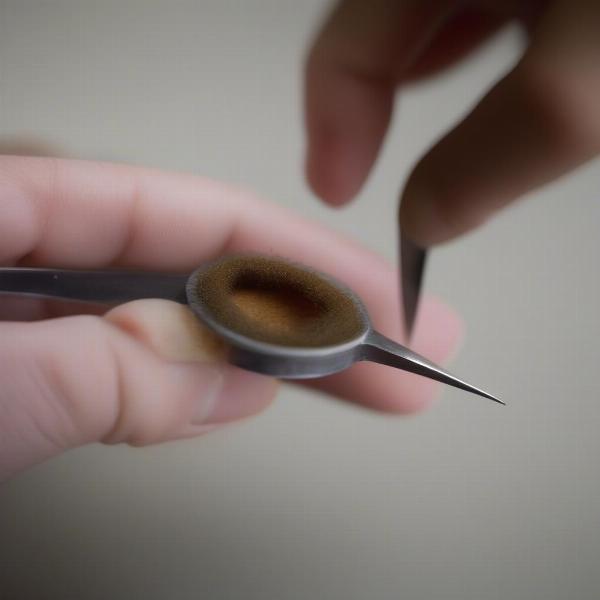Bindi bites, those pesky little seed pods from the bindi weed (Tribulus terrestris), can be a real nuisance for dogs, especially during warmer months. These prickly plant parts can attach to their fur, paws, and even work their way into their skin, causing discomfort and potential health issues. This comprehensive guide will explore everything you need to know about bindi bites for dogs, from prevention and removal to treatment and potential complications.
Understanding the Bindi Menace
Bindi weeds thrive in warm, dry climates and are notorious for their sharp, spiky seed pods. These pods easily detach from the plant and cling to anything that brushes against them, including your dog’s fur. While seemingly harmless at first glance, these tiny barbs can cause significant discomfort and even pose health risks if left untreated.
Preventing Bindi Bites in Dogs
The best way to deal with bindi bites is to prevent them in the first place. Here are some effective preventive measures:
- Regular Yard Maintenance: Regularly mowing your lawn and removing bindi weeds before they seed can significantly reduce the risk of exposure.
- Protective Gear: Consider using dog booties, especially when walking in areas known to have bindi weeds.
- Regular Grooming: Frequent brushing, especially after walks, helps to remove bindi pods before they become embedded.
Removing Bindi Bites from Your Dog
If your dog does get bindi bites, it’s important to remove them promptly and carefully. Here’s a step-by-step guide:
- Locate the Bindis: Carefully inspect your dog’s fur, paying close attention to the paws, legs, and underbelly.
- Use Tweezers or a Bindi Removal Tool: Gently grasp the bindi pod with tweezers or a specialized bindi removal tool and pull it out in the direction of hair growth.
- Soothe the Area: After removing the bindi, clean the area with antiseptic wipes or a mild antibacterial solution.
 Removing a bindi from a dog's paw with tweezers
Removing a bindi from a dog's paw with tweezers
Treating Bindi Bite Complications
While most bindi bites are minor irritations, they can sometimes lead to complications such as:
- Skin Infections: If a bindi becomes embedded deep in the skin, it can cause an infection. Signs of infection include redness, swelling, pus, and pain.
- Abscesses: In some cases, a bindi bite can lead to an abscess, a painful pocket of pus under the skin.
- Penetration of Body Cavities: Rarely, bindis can penetrate deeper tissues, such as the nose, ears, or eyes.
If you notice any of these signs, consult your veterinarian immediately.
When to Seek Veterinary Care
While you can often remove bindi bites at home, it’s essential to seek veterinary care if:
- You are unable to remove the bindi yourself.
- The area around the bite becomes infected or inflamed.
- Your dog exhibits signs of pain or discomfort.
- The bindi has penetrated a sensitive area like the eyes, nose, or ears.
Conclusion
Bindi bites can be a painful nuisance for dogs, but with proper prevention and prompt removal, you can minimize the risk of complications. Regular grooming, yard maintenance, and protective gear are key to preventing these prickly pests from bothering your furry friend. If you suspect a bindi bite has become infected or you are unable to remove it yourself, don’t hesitate to consult your veterinarian.
FAQ
- What are bindi bites? Bindi bites are caused by the spiky seed pods of the bindi weed (Tribulus terrestris) attaching to a dog’s fur and skin.
- How can I prevent bindi bites? Regular yard maintenance, protective gear like dog booties, and frequent grooming can help prevent bindi bites.
- How do I remove bindi bites from my dog? Carefully use tweezers or a bindi removal tool to pull the pod out in the direction of hair growth.
- When should I see a vet for a bindi bite? Consult your vet if you can’t remove the bindi, the area is infected, your dog is in pain, or the bindi is in a sensitive area.
- Are bindi bites dangerous for dogs? While usually minor irritations, they can cause infections or abscesses if left untreated.
- What are the signs of a bindi bite infection? Redness, swelling, pus, and pain are signs of infection.
- Can bindis penetrate a dog’s skin? Yes, they can embed themselves in the skin and even penetrate deeper tissues in rare cases.
ILM Dog is your go-to resource for expert advice on all aspects of dog care, from breed selection and health to training, nutrition, and grooming. We offer a comprehensive range of resources to help you provide the best possible care for your canine companion. For expert advice tailored to your dog’s needs, contact us at [email protected] or call us at +44 20-3965-8624. Visit ILM Dog for more valuable information and resources.